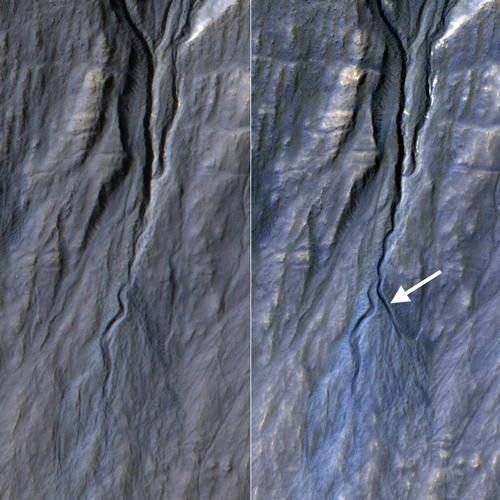New Gully On Mars? NASA Spacecraft Spots Feature Not Visible 3 Years Ago [PHOTO]

Mars has a new gully that formed within the last three years, according to new images recorded by a NASA orbiter.
NASA’s Mars Reconnaissance Orbiter (MRO) captured images of the new gully channel on a crater wall slope in the southern highlands of Mars. The photos were taken on May 25, 2013, using the orbiter's High Resolution Imaging Science Experiment (HiRISE) camera. The gully was not present in a photo taken of the same location in Nov. 5, 2010.
“Although this pair of observations does not pin down the season of the event, locations HiRISE has imaged more often demonstrate that this sort of event generally occurs in winter, when liquid water is very unlikely,” NASA wrote in a statement on March 19.
While the gully may look like a water formation, scientists say carbon dioxide rather than water played a role. This is most likely due to the fact that gullies tend to form in winter months when the planet’s temperature plummets.
Other formations captured by the MRO have been attributed to the presence of water on Mars. This includes dark streaks known as recurring slope lineae (RSL) that snake down crater walls during warmer weather.
Despite these formations, whether water is presently on Mars remains a debated topic among scientists. A recent study unveiled clues that the Red Planet may have free flowing water, at least during its warmer seasons.
The findings come from dark finger-shaped features found on Martian slopes that seem to disappear seasonally.
"In HiRISE images, we see them forming, elongating and then fading over time," Lujendra Ojha, a graduate student at the Georgia Institute of Technology, told CNN. "That's why they're called seasonal -- they form and flow when the temperature is right."
Ojha and his colleagues used the MRO’s spectrometer to looks for chemical signatures on the formations. While they couldn’t find direct evidence of water, they did find “something iron in nature” at the flows.
"We still don't have a smoking gun for existence of water in RSL, although we're not sure how this process would take place without water," Ojha said in a statement.
Ojha suggest the flows may contain ferric sulfate, a chemical compound known to exist on Mars that can lower the melting point of ice. If this is the case, water combined with ferric sulfate would not be able to sustain life.
"The flow of water, even briny water, anywhere on Mars today would be a major discovery, impacting our understanding of present climate change on Mars and possibly indicating potential habitats for life near the surface on modern Mars," Richard Zurek, of NASA's Jet Propulsion Laboratory, Pasadena, Calif., said.
© Copyright IBTimes 2024. All rights reserved.












